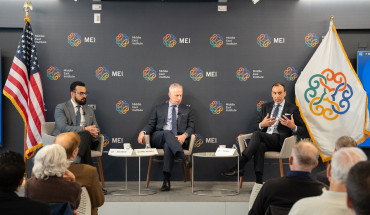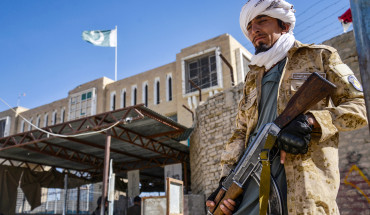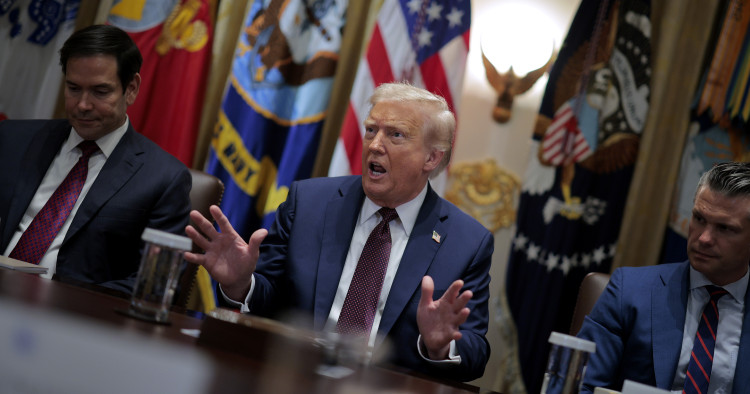The most striking thing about Donald Trump’s foreign policy at the seven-month mark of his second administration is how it has failed to improve America’s overall strategic position in the world.
No doubt, it is still early days in the president’s second term. But the Trump team’s frenetic flurry of actions, coupled with attention-seeking and often incendiary rhetoric, has served to obscure a poor record of scoring significant international wins for America. Trump’s moves at home and abroad have landed him in a weak domestic political position as his ratings with voters remain underwater with no signs of revival, and he has rapidly expended political capital to advance policies that do not appear poised to yield benefits for most Americans anytime soon. In a real sense, Trump has painted himself into a corner with his own political and policy approach — one unlikely to win broader public support at home.
This fundamental is often ignored in the daily onslaught of provocative, norms-bending actions and statements coming from the Trump team. It also helps explain why Trump cuts corners, breaks rules, and unleashes a firehose of untruths on a daily basis: His agenda lacks the political support and capital required to achieve success, a consequence of the “divide and conquer” tactics of governing he deploys, and so he seeks to distract from the paltry results and some actual, self-inflicted damage.
This is particularly true in the Middle East, where Trump’s actions have mostly been inconsequential and incidental to the fact that strategic dynamics are being shaped by actors in the region, particularly Israel and Iran, but also by leaders in places like Syria and Lebanon. On the two big files, Iran and Israel-Palestine, Trump has had an impact — his May visit to the Gulf reinforced a sense of strategic priority and purpose in US policy in the region. The decisions made thus far on Syria and Lebanon demonstrate a clear-eyed pragmatism that is not present with other key foreign policy files, and his Iran policy has added to the damage Israel did to that country and its network of regional partners.
But Trump has also left much unfinished business with Iran as its nuclear program and ambitions remain intact, if degraded. And the biggest unresolved issue is on the Israeli-Palestinian front, where a war still rages on, scores of Palestinians are killed on a daily basis, people are dying of hunger, and Israeli hostages languish in the grip of Hamas.
Unfulfilled Trump promises on Gaza and the Israel-Hamas war
Trump’s Middle East envoy announced on Tuesday that the White House would hold a meeting this week to discuss a comprehensive plan for managing the post-war situation in Gaza. One of the likely reasons for this move is the lack of traction and results Trump 2.0 has produced on this front.
As a reminder, the second Trump administration came into office with a cease-fire in place between Israel and Hamas that produced more hostage releases and additional aid to Gaza for a few weeks, but which collapsed in March when Israel unilaterally restarted military operations and imposed a siege on Gaza that cut off flows of aid delivery, resulting in a disastrous decline in humanitarian conditions that, according to the United Nations, can now be called a famine.
The meeting held Wednesday came after a stream of promises made by Trump over the past few months to step up humanitarian aid to Palestinians in Gaza — promises that have not been fulfilled as the situation has worsened. At the end of his Middle East trip in May, Trump acknowledged that “a lot of people are starving” in the devastated coastal strip and stated that the administration was “looking at Gaza.” Since late spring and early summer, Trump has promised a new and expanded approach to deal with the unfolding humanitarian crisis — an acknowledgment of the obvious flaws and shortcomings in the broader provision of aid, and particularly the role of the Gaza Humanitarian Foundation.
Trump is aware of the magnitude of the crisis. In late July, when he was asked if he agreed with Israeli Prime Minister Benjamin Netanyahu’s claims that there is no starvation in Gaza, Trump responded by saying “…those children look very hungry.” During his meeting with Prime Minister Keir Starmer in Scotland, he described the situation as “real starvation stuff,” stating that he “see[s] it and you can’t fake that.” Trump also stated late last month that he was going to “make sure that [food centers] don’t have barriers stopping people” and that the US would “get rid of those lines” that hinder people from accessing food at the distribution centers. He vowed that the US would be “even more involved” due to the hunger crisis spreading in Gaza. A month later, it remains to be seen what the United States might actually do differently here — and how these humanitarian crisis efforts might connect to broader attempts to achieve a cease-fire and hostage release deal as well as longer-term efforts to produce a sustainable end to the conflict.
The White House meeting on Gaza, which included former British Prime Minister Tony Blair and former Trump Middle East envoy Jared Kushner, both of whom have worked on various plans for Gaza’s post-war future, has not yet produced any apparent notable outcomes. It seems unlikely that any significant effort on Gaza would succeed without substantial support and buy-in from leading Arab countries, particularly those with the financial resources and diplomatic ties with Palestinians that will be required for the multi-year project of rebuilding the enclave and producing a pathway to a lasting peace settlement. Trump 2.0 has not yet fully engaged these Arab partners on their proposals and ideas for the future on the Israel-Palestine front, and he has also taken steps that have alienated some of these countries. A sustainable solution will require a regional team effort that the Trump administration has not yet assembled.
Not a promising track record from Trump 2.0’s broader foreign policy approach
The second Trump administration’s mixed record on the Middle East thus far, analyzed in this six-month report card assessment, shows significant room for improvement — and any genuine progress from Wednesday’s meeting on the Gaza front would be welcome news. But it is important to keep in mind that meetings and public statements do not make an effective foreign policy, a lesson that the Trump team should have learned from its efforts to end Russia’s war in Ukraine, which have fallen flat despite many meetings and statements.
Trump’s unsuccessful efforts to produce results with Russia, the foreign policy priority he spotlighted in the opening months of his second term, reflect negatively on his diplomatic efforts in the Middle East. Add to that the lack of clear benefits coming to the US from Trump’s tariff wars and the unresolved status of America’s strategic competition with China, and we are naturally left waiting to hear whatever might develop out of the White House meeting on Gaza.
As with all things related to President Trump’s policy and political moves, it is important to separate the signal from the noise and look closely at what the next steps in implementing a policy will be. Trump is desperately seeking a personal win and has tried to cast himself as a peacemaker on multiple fronts, but the proof will come only with tangible results that benefit someone other than Trump and his inner circle — like fewer Palestinians getting killed by Israeli military strikes and more Israeli hostages coming home.
Brian Katulis is a Senior Fellow at the Middle East Institute.
Photo by Chip Somodevilla/Getty Images
The Middle East Institute (MEI) is an independent, non-partisan, non-for-profit, educational organization. It does not engage in advocacy and its scholars’ opinions are their own. MEI welcomes financial donations, but retains sole editorial control over its work and its publications reflect only the authors’ views. For a listing of MEI donors, please click here.













